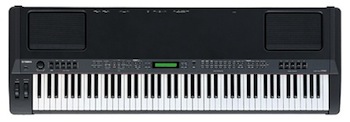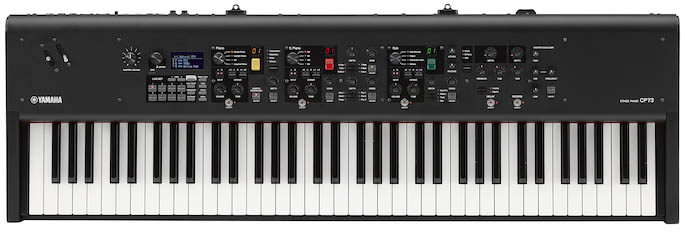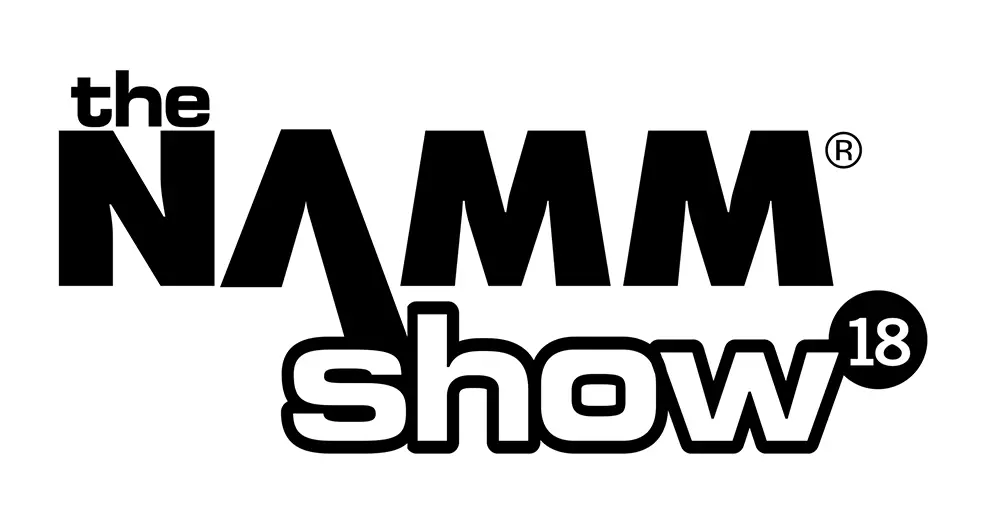We also have a full comparison of these keyboards alongside Yamaha’s new CK Series instruments.
Yamaha’s varied line of stage keyboards, designed to make it easy for those in performance situations to access the sounds and transitions they require with ease, offer a range of features. Here we compare the current line of instruments, including the YC and CP series.
Jump to specific section:
Yamaha YC Series
Yamaha says theYC series, which currently contains three models with varying number of keys, is designed for performance, featuring Virtual Circuitry Modeling organ technology with physical drawbars, intuitive control, authentic acoustic and electric piano and FM synths.
Overview
Each of the three keyboards is designed to appeal to a slightly different musician. The 61 key YC61 version features ‘waterfall’ style non-weighted keys best suited for those used to playing organs and synths. The 73 key YC73 version has a light weighted action akin to electric pianos, while the 88 key YC88 model has a fully weighted and graded action like a grand piano.
Sounds include authentic pianos, electric pianos and organs, and Yamaha’s Virtual Circuitry Modelling is designed to produce realistic sounds which are highly customisable as required. The drawbars offer immediate access to shaping organ and other sounds. The keyboards have all been designed to be easily transportable.
Specifications
|
|
YC61 |
YC73 |
YC88 |
|
|
Control Interface |
||||
|
Keyboard |
Number of Keys |
61 |
73 |
88 |
|
Type |
Semi-weighted Waterfall keyboard, initial touch |
BHS (Balanced Hammer Standard) keyboard: matte black keytops |
NW-GH3 (Natural Wood Graded Hammer) keyboard: synthetic ebony and ivory keytops |
|
|
Voices |
||||
|
Tone Generation |
Tone Generating Technology |
VCM Organ, AWM2, FM |
||
|
Polyphony |
Number of Polyphony (Max.) |
[VCM Organ + AWM2]:128 *Total of VCM Organ and AWM2, [FM]:128 |
||
|
Number of Live Set Sound |
160 (Preset Live Set Sounds:80) |
160 (Preset Live Set Sounds:104) |
||
|
Number of Voices |
145 (Organ:6 / Keys:139) |
152 (Organ:9 / Keys:143) |
||
|
Effects |
||||
|
Types |
Insertion Effect |
Organ 1 systems (Pre Drive) / Key A 2 systems (1: 32 types, 2: 32 types) / Key B 2 systems (1: 32 types, 2: 32 types) |
Organ 1 systems (Pre Drive) / Key A 2 systems (1: 35 types, 2: 35 types) / Key B 2 systems (1: 35 types, 2: 35 types) |
|
|
Effect |
32 types |
35 types |
||
|
Speaker/Amp |
6 types (Rotary Speaker: 2 types, Amp: 4 types) |
7 types (Rotary Speaker: 3 types, Amp: 4 types) |
||
|
Reverb |
1 type |
|||
|
Master EQ |
3 band (with sweepable Mid) |
|||
|
Connectivity |
||||
|
Connectors |
Line Out |
OUTPUT [L/MONO]/[R] (6.3 mm, standard phone jacks, UNBALANCED) |
OUTPUT [L/MONO]/[R] (6.3 mm, standard phone jacks, UNBALANCED), OUTPUT [L]/[R] (XLR jacks, BALANCED) |
|
|
Headphones |
[PHONES] (6.3 mm, standard stereo phone jack) |
|||
|
Foot Controller |
FOOT CONTROLLER [1]/[2], FOOT SWITCH [SUSTAIN]/[ASSIGNABLE] |
|||
|
MIDI |
MIDI [IN]/[OUT] |
|||
|
USB |
USB [TO HOST]/[TO DEVICE] |
|||
|
AUX |
INPUT [L/MONO]/[R] (6.3 mm, standard phone jacks) |
|||
|
Other |
||||
|
Connectors |
[AC IN] |
|||
|
Display |
Full Dot LCD (128 x 64 dots) |
|||
|
Additional package contents |
Owner’s Manual x 1, Power cord x 1 |
Owner’s Manual x 1, Power cord x 1, Foot pedal (FC3A) x 1 |
||
|
Size/Weight |
||||
|
Dimensions |
Width |
35-1/4″ (896 mm) |
1086 mm (42-3/4″) |
1298 mm (51-1/8″) |
|
Height |
4-1/4″ (108 mm) |
145 mm (5-11/16″) |
142 mm (5-9/16″) |
|
|
Depth |
12-3/16″ (309 mm) |
355 mm (14″) |
364 mm (14-5/16″) |
|
|
Weight |
Weight |
15 lb (7.1 kg, 10 oz) |
13.4 kg (29 lb, 9 oz) |
18.6 kg (41 lb, 0 oz) |
|
RRP |
$2499 |
$2999 |
$3499 |
|
|
Release Date |
2020 |
2021 |
2021 |
|
Yamaha CP Series
The Yamaha CP series of stage pianos features nine models which Yamaha is still publicising, with a range of specifications and abilities.







Overview
Yamaha has really pushed its stage pianos over the years, claiming them to be of very high quality and combining state of the art piano and real world sounds with portability and ease of use in a live performance setting.
All feature 88 full sized graded hammer weighted keys (except for the CP73 which has 73 keys) and a good range of connectivity for pedals and audio. No speakers on board as gigging musicians often prefer a lightweight instrument and connect up to on-stage PA/speakers.
Specifications
|
Model |
CP1 |
CP300 |
CP33 |
CP4 STAGE |
CP40 STAGE |
CP5 |
CP50 |
CP73 |
CP88 |
|
Polyphony |
128 |
128 |
64 |
128 |
128 |
128 |
128 |
128 |
128 |
|
Number of Keys |
88 |
88 |
88 |
88 |
88 |
88 |
88 |
73 |
88 |
|
Number of voices |
17 |
530 |
28 |
433 |
297 |
322 |
227 |
127 |
127 |
|
Sound generation |
SCM |
AWM |
AWM |
SCM/AWM2 |
SCM/AWM2 |
SCM/AWM2 |
SCM/AWM2 |
AWM2 |
AWM2 |
|
Key weight |
Fully weighted |
Fully weighted |
Fully weighted |
Fully weighted |
Fully weighted |
Fully weighted |
Fully weighted |
Fully weighted |
Fully weighted |
|
Key size |
Full |
Full |
Full |
Full |
Full |
Full |
Full |
Full |
Full |
|
Touch sensitive |
Y |
Y |
Y |
Y |
Y |
Y |
Y |
Y |
Y |
|
Aftertouch |
N |
N |
N |
N |
N |
N |
N |
N |
N |
|
Piano sounds |
Y |
Y |
Y |
Y |
Y |
Y |
Y |
Y |
Y |
|
Real world sounds |
Y |
Y |
Y |
Y |
Y |
Y |
Y |
Y |
Y |
|
Editable sounds |
N |
N |
N |
N |
N |
N |
N |
N |
N |
|
Accompaniments |
N |
N |
N |
N |
N |
Y |
Y |
N |
N |
|
Recorder |
N |
Y |
N |
N |
N |
N |
N |
N |
N |
|
Tutorials |
N |
N |
N |
N |
N |
N |
N |
N |
N |
|
MIDI |
Y |
Y |
Y |
Y |
Y |
Y |
Y |
Y |
Y |
|
USB |
Y |
Y |
Y |
Y |
Y |
Y |
Y |
Y |
Y |
|
Tablet |
N |
N |
N |
N |
N |
N |
N |
N |
N |
|
Audio Out |
Y |
Y |
Y |
Y |
Y |
Y |
Y |
Y |
Y |
|
Audio In |
N |
N |
N |
N |
N |
N |
N |
Y |
Y |
|
Power Supply |
Y |
Y |
Y |
Y |
Y |
Y |
Y |
Y |
Y |
|
Battery |
N |
N |
N |
N |
N |
N |
N |
N |
N |
|
Speakers |
N |
N |
N |
N |
N |
N |
N |
N |
N |
|
Sustain pedal |
Y |
Y |
Y |
Y |
Y |
Y |
Y |
Y |
Y |
|
Soft pedal |
N |
N |
N |
Y |
Y |
N |
N |
N |
N |
|
Expression pedal |
N |
N |
N |
Y |
Y |
N |
N |
Y |
Y |
|
Year |
2010 |
2010 |
2010 |
2013 |
2013 |
2010 |
2010 |
2019 |
2019 |
|
RRP |
$6000 |
$2900 |
$1700 |
$2999 |
$2000 |
$2600 |
$1700 |
$2499 |
$3199 |
Comparing YC to CP
It’s quick to look at the specs for the two distinct groups of keyboards, but let’s take quick look at how the YC and CP models compare to one another.
For a start, the Yamaha CP series has been around for many more years, and is focused on a premium full-size piano experience in a portable unit. By contrast, the Yamaha YC series, although still categorised in the stage piano category, aims to cast its net a little wider to appeal to organ and electric piano players as well as straight pianists.
The high end YC88, featuring a full 88-key weighted keyboard, is the most comparable to the latest CP88, although it commands a higher price tag possibly because it is a couple of years newer and also includes more functionality for organ simulation.
Musicians after a lighter playing feel and overall size are catered for by the YC61 and YC73 instruments, which someone requiring a more authentic piano feel may become frustrated with. Both 73 key models feature slightly lighter weighting key action, somewhere between organ/synth style and fully weighted piano keys.
As always, it really depends what you’re planning to do. If you’re a gigging musician, focus on what your primary playing style and preference is. If you’re doing a lot of acoustic piano focused work, either the YC88 or one of the 88-key CP models will suit you very well. If you want really good organ as well, the YC88 probably wins out, although you pay more for the privilege and the CP is not completely lacking in this department either.
If you want a lighter touch for blazing organ solos and can get by with a five octave keyboard, the YC61 will do you well. The YC73 is a happy medium, with not overly heavy keys meaning you get a decent experience on both piano and organ (and synth, etc.) performances.
That is, of course, if you go for one of these at all. There are plenty of alternatives from other manufacturers, and indeed from Yamaha, if you are more into studio work, want the onboard speakers, need synth capability, and so on. That said, these are very capable and high quality instruments in their own right, packing in many of Yamaha’s renowned piano, EP and organ sounds.
Yamaha CP88 vs YC88
Let’s take a look at how the two newest 88-key stage pianos in these ranges compare to each other.
Sound: Acoustic Pianos
Both instruments feature outstanding acoustic pianos including the Yamaha CFX flagship 9′ concert grand, the S700, and C7 ‘most recorded piano in music history’.
The YC88 also feature the Nashville C3 grand piano and a live CF3 sound from the CP300 stage piano, while the CP88 has the Bösendorfer Imperial 290 grand piano, the U1 upright piano and the SU7 flagship upright piano.
Sound: Electric Pianos
Both CP88 and YC88 feature the Yamaha CP80, 75 Rd, 73 Rd and Wr. The YC88 has 78 Rd, 73 Rd Studio, and 74 Rd Studio. The CP88 has 76 Rd.
Sound: Organ
Both instruments feature Virtual Circuitry Modelling which emulates a range of classic organs and are highly editable.
Sound: Others
Both instruments feature a range of synthesised and string/pad sounds to add to performance possibilities.
Specification Comparison
|
|
YC88 |
CP88 |
|
Number of Keys |
88 |
88 |
|
Keyboard Type |
NW-GH3 (Natural Wood Graded Hammer) keyboard: synthetic ebony and ivory keytops |
NW-GH (Natural Wood Graded Hammer) keyboard: synthetic ebony and ivory keytops |
|
Tone Generation |
VCM Organ, AWM2, FM |
AWM2 |
|
Polyphony |
128 |
128 |
|
Number of voices |
152 |
57 |
|
Number of live set sound |
160 |
– |
|
Insertion Effects |
Organ 1 systems (Pre Drive) / Key A 2 systems (1: 35 types, 2: 35 types) / Key B 2 systems (1: 35 types, 2: 35 types) |
Piano: 2 systems (1: Damper Resonance / 2: Compressor, Distortion, Drive, Chorus), E. Piano: 3 systems (1: Drive / 2: Auto Pan, Tremolo, Ring Modulator, Touch Wah, Pedal Wah, Compressor / 3: Chorus1, Chorus2, Flanger, Phaser1, Phaser2, Phaser3), Sub: 1 system (Chorus/Flanger, Rotary Speaker, Tremolo, Distortion) |
|
Reverb |
1 type |
1 type |
|
Master EQ |
3 band (with sweepable mid) |
3 band (with sweepable mid) |
|
Line Out |
OUTPUT [L/MONO]/[R] (6.3 mm, standard phone jacks, UNBALANCED), OUTPUT [L]/[R] (XLR jacks, BALANCED) |
OUTPUT [L/MONO]/[R] (6.3 mm, standard phone jacks, UNBALANCED), OUTPUT [L]/[R] (XLR jacks, BALANCED) |
|
Headphones |
[PHONES] (6.3 mm, standard stereo phone jack) |
[PHONES] (6.3 mm, standard stereo phone jack) |
|
Foot Controller |
FOOT CONTROLLER [1]/[2], FOOT SWITCH [SUSTAIN]/[ASSIGNABLE] |
FOOT CONTROLLER [1]/[2], FOOT SWITCH [SUSTAIN]/[ASSIGNABLE] |
|
MIDI |
In/Out |
In/Out |
|
USB |
USB [TO HOST]/[TO DEVICE] |
USB [TO HOST]/[TO DEVICE] |
|
AUX |
INPUT [L/MONO]/[R] (6.3 mm, standard phone jacks) |
INPUT [L/MONO]/[R] (6.3 mm, standard phone jacks) |
|
Connectors |
AC In |
AC In |
|
Display |
Full Dot LCD (128 x 64 dots) |
Full Dot LCD (128 x 64 dots) |
|
Accessories included |
Owner’s Manual x 1, Power cord x 1, Foot pedal (FC3A) x 1 |
Owner’s Manual x 1, Power cord x 1, Foot pedal (FC3A) x 1 |
|
Dimensions |
WxHxD 51.125”x5.5625”x14.3125” (1298x142x364mm) |
WxHxD 51.125”x5.5625”x14.3125” (1298x141x364mm) |
|
Weight |
41lbs (18.6kg) |
41lbs (18.6kg) |
Yamaha CP73 vs YC73
The 73-key models of each range share the same specifications as their 88-key equivalents, with the exception that they both feature less weighted Balanced Hammer Standard key mechanisms rather than the Natural Wood Graded Hammer Action of the 88-key models.
Specification Comparison
|
|
YC73 |
CP73 |
|
Number of Keys |
73 |
88 |
|
Keyboard Type |
BHS (Balanced Hammer Standard) keyboard: matte black keytops |
NW-GH (Natural Wood Graded Hammer) keyboard: synthetic ebony and ivory keytops |
|
Tone Generation |
VCM Organ, AWM2, FM |
AWM2 |
|
Polyphony |
128 |
128 |
|
Number of voices |
152 |
57 |
|
Number of live set sound |
160 |
– |
|
Insertion Effects |
Organ 1 systems (Pre Drive) / Key A 2 systems (1: 35 types, 2: 35 types) / Key B 2 systems (1: 35 types, 2: 35 types) |
Piano: 2 systems (1: Damper Resonance / 2: Compressor, Distortion, Drive, Chorus), E. Piano: 3 systems (1: Drive / 2: Auto Pan, Tremolo, Ring Modulator, Touch Wah, Pedal Wah, Compressor / 3: Chorus1, Chorus2, Flanger, Phaser1, Phaser2, Phaser3), Sub: 1 system (Chorus/Flanger, Rotary Speaker, Tremolo, Distortion) |
|
Reverb |
1 type |
1 type |
|
Master EQ |
3 band (with sweepable mid) |
3 band (with sweepable mid) |
|
Line Out |
OUTPUT [L/MONO]/[R] (6.3 mm, standard phone jacks, UNBALANCED), OUTPUT [L]/[R] (XLR jacks, BALANCED) |
OUTPUT [L/MONO]/[R] (6.3 mm, standard phone jacks, UNBALANCED), OUTPUT [L]/[R] (XLR jacks, BALANCED) |
|
Headphones |
[PHONES] (6.3 mm, standard stereo phone jack) |
[PHONES] (6.3 mm, standard stereo phone jack) |
|
Foot Controller |
FOOT CONTROLLER [1]/[2], FOOT SWITCH [SUSTAIN]/[ASSIGNABLE] |
FOOT CONTROLLER [1]/[2], FOOT SWITCH [SUSTAIN]/[ASSIGNABLE] |
|
MIDI |
In/Out |
In/Out |
|
USB |
USB [TO HOST]/[TO DEVICE] |
USB [TO HOST]/[TO DEVICE] |
|
AUX |
INPUT [L/MONO]/[R] (6.3 mm, standard phone jacks) |
INPUT [L/MONO]/[R] (6.3 mm, standard phone jacks) |
|
Connectors |
AC In |
AC In |
|
Display |
Full Dot LCD (128 x 64 dots) |
Full Dot LCD (128 x 64 dots) |
|
Accessories included |
Owner’s Manual x 1, Power cord x 1, Foot pedal (FC3A) x 1 |
Owner’s Manual x 1, Power cord x 1, Foot pedal (FC3A) x 1 |
|
Dimensions |
WxHxD 42.75”x5.6875”x14” (1086x145x355mm) |
WxHxD 42.75”x5.6875”x14″ (1086x144x355mm) |
|
Weight |
29lb9oz (13.4kg) |
28lb14oz (13.1kg) |
We also have a full comparison of these keyboards alongside Yamaha’s new CK Series instruments.






